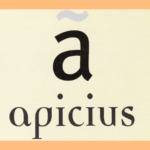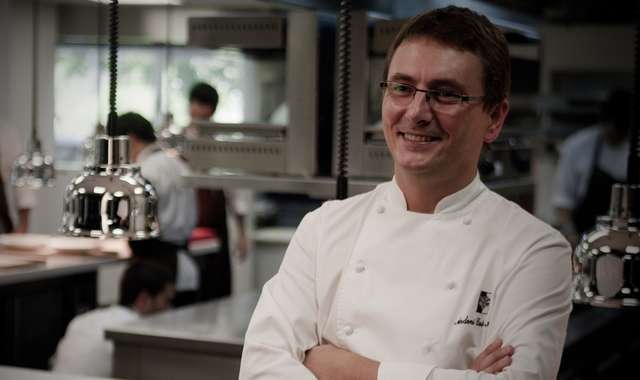By Sofia Perez
[Published by Food Arts, October 2007]
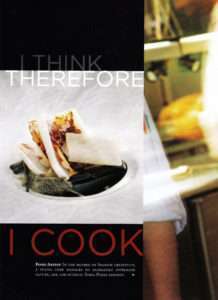 A drive through the hills of the Basque Country, in northern Spain, reveals the color green in a seemingly infinite variety of shades. The region gets its fair share of rain, and it shows in the landscape—a lush, dense cover of trees and vegetation. About a half-hour’s drive from the beaches and Belle Époque streets of San Sebastián, nestled amid the branches and leaves, and almost hidden from view until you’re halfway up the driveway, is the restaurant Mugaritz, a Michelin two-star that is ranked number seven on the British publication Restaurant Magazine’s list of the world’s 50 best restaurants.
A drive through the hills of the Basque Country, in northern Spain, reveals the color green in a seemingly infinite variety of shades. The region gets its fair share of rain, and it shows in the landscape—a lush, dense cover of trees and vegetation. About a half-hour’s drive from the beaches and Belle Époque streets of San Sebastián, nestled amid the branches and leaves, and almost hidden from view until you’re halfway up the driveway, is the restaurant Mugaritz, a Michelin two-star that is ranked number seven on the British publication Restaurant Magazine’s list of the world’s 50 best restaurants.
The restaurant, housed in a country cottage, somehow manages to be both rustic and modern at the same time. This duality, the ability to exist between two contradictory ideas and yet carve out a space all its own, is a recurring theme at Mugaritz, a place that proves the notion that restaurants are a direct expression of the personality and values of the chef—in this case, Andoni Luis Aduriz.
If you spend time with the 36-year-old San Sebastián native, you’ll understand why Mugaritz is a restaurant that thrives on nuance, layers of meaning, and a constant questioning of the so-called natural order. Indeed, nature is such an integral element in Aduriz’s work and life that in July 2006 he gave a presentation entitled “Nature and Innovation” at a gastronomy conference organized by chef Koldo Rodero (Restaurante Rodero) in Pamplona, Spain. Conference co-organizer and expert in European gastronomy Philippe Regol introduced Aduriz by saying, “Andoni was the one who put nature on the plate for the first time in this country.”
Regol’s statement can be taken both literally and figuratively. Aduriz’s food has a purist’s austerity that captures nature in its most elemental form. He uses raw herbs and flowers not as garnishes, but as integral components of a recipe, as in his lyrical dish of assorted vegetables, herbs, sprouts, mushrooms, and flowers—each item hand-picked daily from the restaurant’s garden or the nearby woods, served raw or cooked to different textures, and bathed tableside with a light Emmentaler broth. He never clutters the plate with rococo embellishments, and his presentations often resemble natural tableaux, as in a heart-stoppingly beautiful (and delicious) dessert consisting of a small slope of violet ice cream strewn with a fallen tree trunk of chocolate shavings, and a few mini-boulders of a shortbread-like mixture of pain d’épices, green tea, and ground almonds. The final touch? Three fennel flowers coated and slightly sweetened with lactose, glittering like perfect little crystallized snowflakes, frozen forever in time.
These dishes demonstrate Aduriz’s reverence for the natural world, but if you sit down and talk to him about the connection between nature and innovation, you get another example of his philosopher’s ability to entertain contradictory thoughts simultaneously. “We think of nature as traditional, and innovation as very technical, but it’s really just playing with words,” he says, measuring his own precisely. “The way that plants develop and fight against gravity to grow is a kind of natural technology that in some ways is more ingenious than, say, the efforts of humans to design an aerodynamic car. Nature is very innovative, and innovation can be very natural. The technology that we have at our disposal today can help us get closer to the natural essence of things; the two go hand in hand.”
His friend Josean Martínez Alija, the much-lauded young chef of Restaurante Guggenheim Bilbao, also sees this push and pull in Aduriz’s work: “His cuisine is definitely not laboratory food, but it’s not what you’d call ‘classic’ either. It’s meditative, aromatic, poetic, and very subtle. It an expression of his surroundings.”
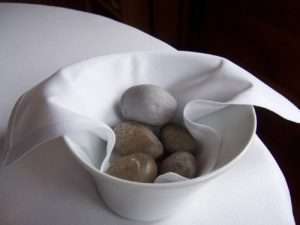
Find the potato at Mugaritz (Photo by Sofia Perez)
Indeed, Aduriz uses innovation in subtle ways, to produce dishes like an amuse-bouche of a small Peruvian potato. He cooks the potato, then coats it in a combination of edible white clay, water, and salt, and dehydrates it just enough to dry the exterior, producing a semi-hard outer shell. Your first bite releases the steam that has been trapped by the coating, which has served to preserve the moisture and sweet starchiness of the potato. Ultimately, what you sees is not the technical innovation or research that made this dish possible; you taste a potato that’s buttery, starchy, and extremely comforting—the Platonic potato.
Nature is part of this dish in another way as well. The chalky coating alters the tuber’s appearance, resulting in a slightly irregular gray orb that resembles a stone. Aduriz plates it in a small bowl filled with four actual rocks that have been warmed to match the potato’s temperature, and the diner must proceed carefully to find the food. “No one has broken a tooth yet,” he says, with a smile, “Though the day that someone does, we’ll probably have to stop serving this dish.”
This interplay between nature and man’s gaze upon it runs throughout his work and has clearly captured his imagination as well. “Take a piece of dried wood that’s been smoothed by the waters of a stream,” he says, as we hike up a steep trail in the woods near the restaurant. “The effect of erosion might seem like something beautiful to us, but nature doesn’t do things to be beautiful. Nature is practical. We’re the ones who interpret what we see as beautiful, and that’s a wonderful thing. It’s the human element.”
Others clearly see this element in his work, including Michel Bras, the great French master who has been an inspiration to Aduriz and who believes that the younger chef’s dishes resemble the man who creates them. “His food is like him. It’s pure, just, and direct,” says Bras. “His intelligent cuisine allies itself with modernism, but he does it with real sensibility. It shows that he knows how to preserve humanity in this world of technical cuisine.”
One of the ways that Aduriz has done this is to question just about everything, a reflection of his innate restlessness and an almost self-torturing perfectionism. He enjoys challenging the assumptions inherent in fine dining. “He’s created menus where he works with ingredients that were devalued until not very long ago,” says Martínez Alija. “I remember when he started to work with eggs, and he developed a dish in which the egg was basically the dish. At first, people said it was crazy, but in the end it was, ‘Well, why not do a dish with the egg as the focus?’ His work always has a message.”
Aduriz’s message is to be open to the experience and to allow yourself to be moved. He explains: “I always say, ‘Feel before thinking.’ Sometimes when we think, the first thing we do is fill in the empty spaces with our memories of past flavor experiences. We don’t give new sensations time to register.” José Uranga, a local expert in viticulture and organic farming, echoes this sentiment in his description of a typical meal at Mugaritz. “It’s eating as a reflective act, but it’s a reflection that has to originate down here,” he says, pointing to his stomach, “before it rises to your head.”
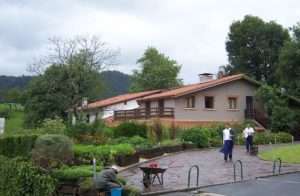
Outside of Mugaritz (Photo by Sofia Perez)
Not surprisingly, Aduriz is a great aficionado of modern art, and its aesthetics and values clearly inform what he does. “Creativity does not lie in the extraordinary,” he says. “It’s in seeing the everyday with new eyes.” During his presentation in Pamplona, he talked about the shared language of creativity. When asked what inspires him, he replies, “Everything. Going to a museum or a concert, for example. What does a concert have to do with gastronomy? Well, nothing really, except that you get to see how, with the use of a language that is specific to that field, someone is able to move and provoke others. If you pay attention to the gestures and the rhythms, it can inspire you more than something that’s explicitly about food.”
This belief has driven him to embark on a variety of multidisciplinary projects over the years, whether it’s collaborating with a university to study the nature of saffron flowers, working with a consulting firm to develop systems for monitoring and evaluating restaurant innovation, or editing book projects like his Tabula: Bacalao and Clorofilia, two award-winning tomes on salt cod and an homage to herbs, flowers, and plants, which not only include stunning food photos and recipes, but also examine the impact of history, culture, folklore, and science on the world of gastronomy.
He has also been asked to write the foreword to the upcoming Spanish translation of Harold McGee’s seminal food science text, On Food and Cooking. McGee himself is a big fan, describing the Basque chef’s work as an example of culinary modernism at its finest. “Andoni’s food is integrated, and the technique melts into the dish itself,” says McGee. “When I ate at Mugaritz, I never got the sense that I was eating the product of experiments. His work is that of an artist whose medium is food.”
For this chef who hardly ever sits still, and for whom intellectual challenges seem to be as necessary as oxygen, the point of his work is as much about producing a reaction in the person who eats it as it is about the flavor of what he or she is actually ingesting—though Aduriz never wants one to exist at the expense of the other. “The day that you lose your passion, the capacity for surprise, you have a serious problem. That’s the day you get old,” he says.
[Mugaritz, Otzazulueta baserria, aldura aldea 20, Errenteria, Gipuzkoa]


